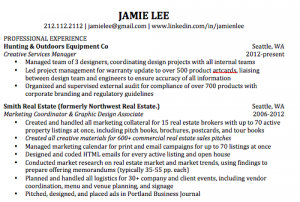
Note: This article’s a Muse original. That’s a nice way of saying that it might be a little bit out-of-date. However, we do have more recent articles on resumes right here and here. If you still don’t see what you’re looking for, send us a note and we’ll do our best to help you out.
Earlier this year, we asked you to send us your resume challenges as part of our Mission: (Resume) Impossible contest. And you definitely did! We got submissions from new grads, from career changers, and from longtime job seekers, and we saw resumes from all types of fields and levels of experiences.
Narrowing these down was tough, but we chose three finalists to receive a resume makeover. And today, we’re not only sharing their “before” and “after” resume looks, we’re giving you the inside scoop on how to make over your own resume.
Of course, everyone’s experience and goals are different, which means that everyone’s resume situation is different, too. But in some ways, we all have the same challenge: It’s really, really hard to condense a career’s worth of experience into one page of compelling bullet points that will sell you as the best person for the job.
So, we applied some of the same strategies across all three Mission: (Resume) Impossible winners, and we think they’ll be useful for you, too, no matter what job you’re gunning for. Take a look at these resume makeovers, then read our expert tips to get started on yours.
The Winners
(Note: Names, contact information, and company names have been changed to protect our winners’ privacy.)
Hannah Fitzgerald
Background: Full-time nanny for a friend for four years, while also running a film nonprofit on a volunteer basis. Over a decade of involvement with film festivals, all as a volunteer
Goal: To land a full-time production or marketing position in a film or entertainment-related company
Jamie Lee
Background: 11-year marketing veteran in real estate
Goal: To launch a new career in the healthcare field, translating her marketing skills to a new industry
Katherine Smith
Background: 6 years of social and email marketing experience, 2 years of events and publicity experience, and a military veteran. Recently completed bachelor’s degree
Goal: To land a new full-time marketing position with better salary and benefits
Our Advice
Look at What’s “Above the Fold”
With each of our candidates, the first thing we did was look at the top third of the page—the part that will show up on the screen when the hiring manager clicks “open” on that PDF. That’s what’s going to make your first impression—so, no matter what you have further down, you should ask yourself if the top third of that page serves as a hook that makes the hiring manager to eager to read more.
What does that mean in terms of specifics? First, don’t let your header (i.e., the block with your name and address) take up too much space. Not only do you want to make sure you’re filling the page with your accomplishments, but you especially don’t want the recruiter missing out on seeing something important because it got pushed too far down the page.
Second, unless you’re a recent graduate, put your education after your experience—because chances are, your last 1-2 jobs are more important and relevant to you getting the job than where you went to college is. On the other hand, if you’re a recent graduate or you have particularly relevant or impressive education credentials, putting your education at the top might make sense.
Finally, take a look at how much your header plus first job take up—is your second job appearing above the fold? Do you want it to? If your most recent job is less relevant than a previous job to the position you’re applying to, keep the bullets under that first job short so the second job also pops out.
 For an example, look at the Hunting & Outdoors Equipment Co. experience on Jamie Lee’s resume—since it reflects only a four-month position, we wanted to make sure her experience at Smith Real Estate (where she worked for seven years across a variety of marketing and design functions) was above the fold.
For an example, look at the Hunting & Outdoors Equipment Co. experience on Jamie Lee’s resume—since it reflects only a four-month position, we wanted to make sure her experience at Smith Real Estate (where she worked for seven years across a variety of marketing and design functions) was above the fold.
Keep it to One Page!
All three of our resume impossible candidates came in with two-page resumes—and we condensed every one of them down to a page. Our reasoning was the same as above—you want to make sure everything important is front and center for the hiring manager. Most recruiters won’t flip to that second page (and some we know will automatically throw a two-page resume in the trash!).
The secret to shortening things up? Well, two things. First, take a look to see if there is space you’re not making good use of. On Katherine Smith’s resume, the formatting she’d chosen for the title and section headers took up quite a bit of space—and by eliminating some of the lines and separations, we were able to give her more space on the page without losing the feel of the formatting.
Second, condense your bullets. No matter how long you’ve been in a job, or how much you’ve accomplished there, you shouldn’t have more than 6-7 bullets in a given section. Why? Because, no matter how good your bullets are, the recruiter just isn’t going to get through them. Recruiters are more often than not skimming your resume—and when skimming a page, nothing catches the eye like the start of a new section. On the other hand, when presented with a long list, the natural tendency is to skip over the end of it, and go on to the next section.
So, pick your best accomplishments and finesse the wording on them (more on that in a minute). Then cut the rest—you can always talk about it in your interview. For a before-and-after example, look at the Smith Real Estate experience on Jamie Lee’s resume—which we took from 17 bullets down to seven.
It’s About the Highlights, Not the Play-by-Play
You don’t have to share every single thing you did at your job on your resume. In fact, you shouldn’t. You want to tell a story, and you want to control the arc of that story—so pick out the accomplishments that help you tell that story, and make those your bullets.
For example, on Katherine Smith’s resume, we wanted to tell the story that she established her company’s first marketing department, recruited a team, and then built a marketing strategy that led to 20% sales growth and reached an audience of 60,000. All those points are in both versions of her resume—the difference is, in the final version, the bullets are crafted and ordered to tell a story, whereas in the original, they feel more like a collection of independent data points on Katherine’s accomplishments.
Recognize, too, that if you’re telling a compelling story—it’s OK if you don’t include the number of Twitter followers you recruited. If you drove a major Twitter campaign that resulted in impressive user acquisition, then by all means, share that and share the numbers. But if you were in charge of leading an integrated social media strategy, you might choose to highlight your strategic development of that plan or the particularly impressive results you got on Facebook—and choose to leave off that Twitter number, even if it’s not bad. And that’s OK.
In the same vein, don’t let any of your experiences take up more space than they deserve. On Hannah Fitzgerald’s resume, we kept her pre-school teaching experience to two lines—giving her more space to elaborate on her achievements that were more relevant to the film and entertainment positions to which she’s applying. And we included four of the most impressive film festivals she’s had a part in, but we gave them their own section so that we could compress all this great information into five lines (compared to 15 lines on her original resume).
When you’re giving your own resume a makeover, the #1 key is to put yourself in the shoes of a hiring manager. Is your resume clean, concise, and compelling? Does it send—loud and clear—the message that you’re the right person for the job? Look at your resume with a critical eye and with these factors in mind, and you’re bound to get noticed.